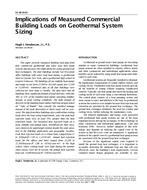Description
This paper presents measured building load data from four commercial geothermal and water loop heat pump systems and discusses the implications for sizing ground loop heat exchangers. The four buildings include two Wisconsin office buildings with water loop heat pumps, a geothermal hotel in Upstate New York, and a geothermal high school in Eastern Tennessee. The buildings all use multiple heat pumps and range in size from 27,000 to 161,600 square feet (2,500 to 15,000 m 2 ). Monitored data at all four buildings were collected for more than 12 months. The data show that all buildings have significant amount of load diversity, with only 38% to 57% of the installed heat pumps operating simultaneously at peak cooling conditions. The high amount of diversity in the building loads implies that loop designs based on ”rules of thumb” that consider the installed tonnage instead of the peak diversified or block loads will be oversized. The data from these buildings also confirm that cooling loads drive the loop sizing requirements, since the peak heat rejection loads were at least 70% greater than the heat extraction loads. The measured heat rejection loads on a peak, monthly and annual basis, normalized for floor area, were shown to be surprisingly similar despite the wide variation in the building application and geographic location. Peak heat rejection loads on a 4-hour basis ranged from 15 to 30 Btu/h-ft 2 (550 to 1,110 W/m 2 ). Annual heat rejection loads for the offices and hotel ranged from 25,200 to 27,300 Btu/year-ft 2 (286 to 310 MJ/year-m 2 ). At the high school, where cooling loads were light during the summer when classes were not in session, the annual heat rejection load was 14,800 Btu/year-ft 2 (168 MJ/year-m 2 ).
Units: Dual
Citation: Symposium, ASHRAE Transactions, vol. 105, pt. 2, Seattle 1999
Product Details
- Published:
- 1999
- Number of Pages:
- 10
- File Size:
- 1 file , 850 KB
- Product Code(s):
- D-7480




